At the Piano
Interviews with 21st-Century Pianists
Caroline Benser
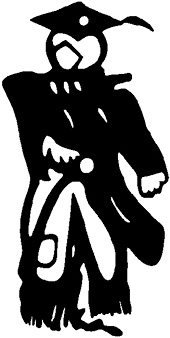
THE SCARECROW PRESS, INC.
Lanham Toronto Plymouth, UK
2012
Published by Scarecrow Press, Inc.
A wholly owned subsidiary of The Rowman & Littlefield Publishing Group, Inc.
4501 Forbes Boulevard, Suite 200, Lanham, Maryland 20706
http://www.scarecrowpress.com
Estover Road, Plymouth PL6 7PY, United Kingdom
Copyright 2012 by Caroline Benser
All rights reserved. No part of this book may be reproduced in any form or by any electronic or mechanical means, including information storage and retrieval systems, without written permission from the publisher, except by a reviewer who may quote passages in a review.
British Library Cataloguing in Publication Information Available
Library of Congress Cataloging-in-Publication Data
Benser, Caroline Cepin, 1944
At the piano : interviews with 21st-century pianists / Caroline Benser.
p. cm.
Includes bibliographical references and index.
ISBN 978-0-8108-8172-3 (cloth : alk. paper) ISBN 978-0-8108-8173-0 (ebook)
1. PianistsInterviews. I. Title.
ML397.B35 2012
786.2092'2dc23
[B]2011027519
 The paper used in this publication meets the minimum requirements of American National Standard for Information SciencesPermanence of Paper for Printed Library Materials, ANSI/NISO Z39.48-1992.
The paper used in this publication meets the minimum requirements of American National Standard for Information SciencesPermanence of Paper for Printed Library Materials, ANSI/NISO Z39.48-1992.
Printed in the United States of America

Acknowledgments
My heartiest thanks go to the pianists themselves who most willingly and graciously shared considerable time and thoughts in the initial interview and in the dialogue of revision. And to the photographers for their outstanding photographs showing each pianist in the act of creating music at the piano: Xavier Antoinet; Greg Helgeson; Ben Ealovega; Grant Hiroshima; Jimmy Katz; Louise Narboni; and Raphael Stein.
Thanks go to Kathleen van Bergen and Sharon Carlson at The Schubert Club of St. Paul, Minnesota. The Schubert Club gave its kind permission to use Richard Sorensens photograph of the stage at the Ordway Center for the Performing Arts in St. Paul. To Sandi Brown of the Minnesota Orchestra, which gave its kind permission for the use of Greg Helgesons photograph of Sudbin performing with the orchestra.
Those who deserve many thanks for their help in putting this series of interviews together include: Charlotte Schroeder at Colbert Artists; Charles Cumella at Cramer Marder Artists; David Hooson at Harrison Parrott; Emma Sweetland and Lucy Jackson at Sulivan Sweetland; Angela Rance and Cate Dennes at IMG Artists, with Kathryn Endicott; Angela Duryea and Lisa Jaehnig at Shuman Associates; Mary Lynn Fixler at Barrett Vantage; Beth Kruse and Catherine Hampton at Hemsing Public Relations; Liz Chew and Laura Monks at EMI Classics; Lorna Aizlewood, VP, Legal and Business Affairs for EMI Records Limited (EMI Classics); Christina Jensen at Christina Jensen Public Relations; and Penelope Axtens at Sony International.
Many thanks to Bennett Graff, Christen Karniski, and Jessica McCleary of Scarecrow Press for the pleasure of working together.
Gratitude goes to colleagues and personal friends for their advice and suggestions: Eric Kraemer, James Wheat, and Deborah Buffton of La Crosse, Wisconsin, and Stephen Willier of Philadelphia. To Mary Goyette of the La Crosse Public Library for her help and countless courtesies. A big debt of thanks goes to Ann McCutchan of Denton, Texas, for her friendship and the earlier inspiration she passed along through her own absorbing series of interviews with American composers. To Teresa Dybvig of Stony Brook, New York, for her long friendship, teaching, and expertise on healthy playing; she is more responsible for this book than she realizes. To longtime friend and pianist Dennis Eppich of Iowa City, Iowa, for his suggestions, helpful corrections, and gentle encouragement for many years. To Sue Hessel of La Crosse for her invaluable technological expertise and advice. And finally a special thanks to my husband, Jerry Benser, for his advice and enduring patience.
Note
1. Ann McCutchan, The Muse That Sings: Composers Speak about the Creative Process (New York: Oxford University Press, 1999).

Introduction
The eight pianists interviewed here, from my earliest interview with Leif Ove Andsnes in 2005 to my last with Yuja Wang in 2010, are representative of the finest pianists playing during the first decade of the 21st century. The choices are mine alone. My aim was to explore pianistic activity during this decade and, further, to explore aspects of life germane to this world. Who are the top pianists keeping good playing alive? Other questions came to mind: Are the masterpieces of several centuries of piano literature being well served by pianists who continue to discover fresh ideas about these masterpieces? Are older pieces of exceptional music being revived? Do contemporary composers find challenges in writing distinctively new, exciting music for pianists by working with them and, likewise, are pianists interested in commissioning and playing this new music? Are pianists in this decade drawn to being creative by composing, arranging, and improvising?
I have heard each of these exceptional artists in live performance, met each one, and listened closely to their recordings. Most of the interviews were conducted by telephone because it was convenient for both of us with regard to geography and their performing schedules. Having enjoyed their music-making beyond measure, I readily confess that I am an unabashed fan of each.
With the founding in 2005 of YouTube, the video-sharing website, pianists both historic and contemporary, are now seen and studied in video clips by thousands of viewers. Early on, these YouTube clips were quite short and made mostly by amateurs. Today lengthier and more professional clips are being uploaded and now join the earlier clips. During this decade, many pianists, including a number interviewed here, are writing blogsonline journalson a variety of subjects on their websites. Some blog much more frequently than others. Stephen Hough continues to contribute regularly to his popular blog begun in 2008 for Londons Telegraph.
Each pianist interviewed is known on the international musical scene, making appearances at the major recital and concert halls of the world, and participating in leading music festivals. They perform solo recitals, make concerto appearances with the worlds major orchestras and conductors, and collaborate in chamber music performances with violinists, cellists, clarinetists, singers, and string quartets. As well, each maintains an active recording schedule. Several have joined noted musical institutions as teachers, which for some is in a limited capacity.
Each one was drawn well before the age of 10 to express his musicality through the awkward instrument that is the piano. Each has extreme technical facility. Each is an athlete of the small muscles of the hands and fingers. A high degree of personal discipline, along with a burning passion for their art, belong to each. Each knows he is doing the only thing in life that he must be doing. The only thing he can do. Much is accomplished in isolation, in focused listening. Sound is of paramount importance. Discovering how to create the sound heard in the inner ear is the work of a lifetime; thus, listening is important. Artistic originality requires serious study, thought, introspection, and scrutiny. Thus complete solitude and silence is necessary. Each is imbued with a high degree of musical imagination. He develops his own ideas about what he wishes to communicate about the music. Each plays the literature for which he has a strong affinity. He spends enormous time season after season stretching to learn music new to him, but it must be music he understands and loves. He constantly guards against falling into mere repetition. A fine performer does not hold back by being too conservative or cautious; he must be open to spontaneity. For that element of unpredictability, he must have loads of courage, self-confidence, and a willingness to rise continually to new challenges. He trusts his technical facility, his musical ideas, and his ability to communicate his personal musical intentions as well as those of the composer. And finally, each has the physical and emotional stamina required for the rigors of traveling and dealing with unexpected events that occur in the course of ever-changing travel schedules and closely scheduled performances.

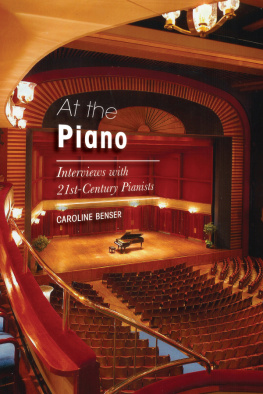
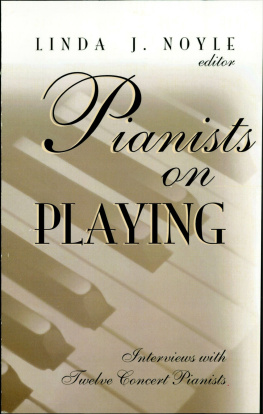


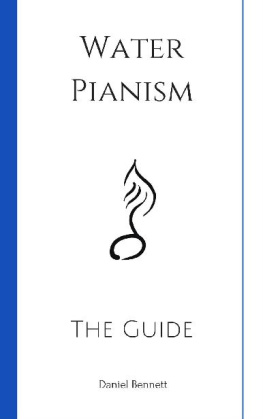

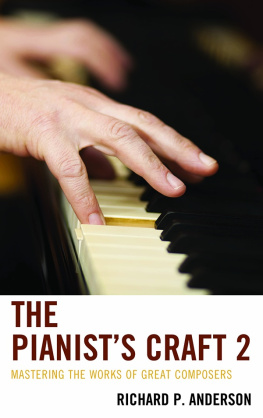
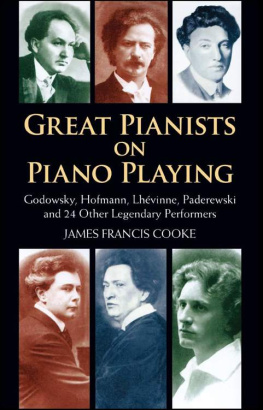

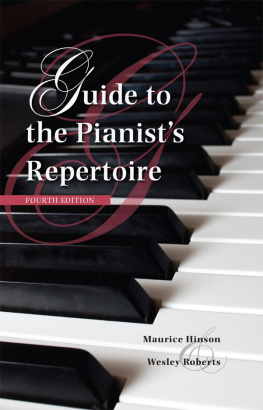



 The paper used in this publication meets the minimum requirements of American National Standard for Information SciencesPermanence of Paper for Printed Library Materials, ANSI/NISO Z39.48-1992.
The paper used in this publication meets the minimum requirements of American National Standard for Information SciencesPermanence of Paper for Printed Library Materials, ANSI/NISO Z39.48-1992.
